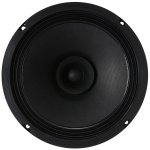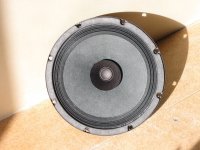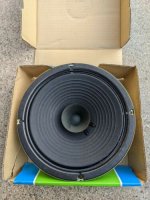Ebay. Maybe helps pay for some of the second hand purchase.Those big black caps will set you back at least 100$. Each.
Linus Tech Tips takes on PC Audiophoolery products:
He's wasting his time.... He won't convince any believers... I say let them spend - a phool and his money etc - and it must be good for the economy!
Good heavens - you couldn't write an agenda for such nonsense. Buy a bunch of stuff to reduce noise, and make it worse!
So tell me, which is the more expensive "ceiling speaker" touted as "special" & deserving of accolades...I have a business proposal, buy up a quant local barely surviving business creating ceiling speakers...we'll give it the name of a wild animal, hype it up with lots of flaky prose & sell it for three times the price it previously was...we'll make a fortune!
----------------------------------------------------------------------------------------------------------------------------------------------------------------Rick...
----------------------------------------------------------------------------------------------------------------------------------------------------------------Rick...
Attachments
There are many who want to believe.
Long ago I noticed my floors aren't level, and instead of leveling my triple component wide stereo rack/record storage unit, made a couple of tripod plinths to level from threaded speaker spikes and some butcher block cutting boards I had laying around.
An audiophile who had come to buy a turntable told me all about how coupling the shelves with leveling spikes to the rack would not actually couple them, but would instead isolate them from floor vibrations.
And tired of dressing stiff audiophile power cables I bought in the late 90's, I used bulk Kimber lookalike braided cables instead, as long as their rated wattage handling exceeded the components by at least 400%.
He went on and on about how they could never be power cables, and that was maybe 3 years ago for most of them. He especially didn't like the wallplugs I'd used- some Hubbell grounded plugs I'd brought home from work, where I use them to replace the burnt up OEM plugs on concrete drills, circular saws, hand and table models.
He actually told me the uncertainty principle would allow the electrons to under perform if they didn't go through an audiophile plug.
When I asked if he meant like the near 50 year old one on the end of a favorite turntables lampcord/powercord, he said no doubt they had designed it with their ears.
Sometimes I think PT Barnum had it right.
Long ago I noticed my floors aren't level, and instead of leveling my triple component wide stereo rack/record storage unit, made a couple of tripod plinths to level from threaded speaker spikes and some butcher block cutting boards I had laying around.
An audiophile who had come to buy a turntable told me all about how coupling the shelves with leveling spikes to the rack would not actually couple them, but would instead isolate them from floor vibrations.
And tired of dressing stiff audiophile power cables I bought in the late 90's, I used bulk Kimber lookalike braided cables instead, as long as their rated wattage handling exceeded the components by at least 400%.
He went on and on about how they could never be power cables, and that was maybe 3 years ago for most of them. He especially didn't like the wallplugs I'd used- some Hubbell grounded plugs I'd brought home from work, where I use them to replace the burnt up OEM plugs on concrete drills, circular saws, hand and table models.
He actually told me the uncertainty principle would allow the electrons to under perform if they didn't go through an audiophile plug.
When I asked if he meant like the near 50 year old one on the end of a favorite turntables lampcord/powercord, he said no doubt they had designed it with their ears.
Sometimes I think PT Barnum had it right.
"He actually told me the uncertainty principle would allow the electrons to under perform if they didn't go through an audiophile plug."
Wow... just wow...
Wow... just wow...
There are many who want to believe.
An (so-called) "audiophile" who had come to buy a turntable told me (a bunch of nonsense)
There certainly are those types roaming around out there.Sometimes I think PT Barnum had it right.
Always was, and always will.
I label them brainwashed, gullible, delusional, and eccentric, depending on their so-called "beliefs".
Much like the addicted cellphone-carrying zombies walking the streets, they live in their own world.
Electrons in a metal are in constant motion because the metal is not at absolute zero, it is at room temperature. The electrons in copper are travelling at around a million metres per second in random directions - so about 0.3% the speed of light, in constant random motion. Also because the metal is at room temperature, the atoms themselves are jiggling around a bit, so the electrons scatter elastically every few hundred atomic diameters (typically 40 nanometres mean free path).
So imagining these high speed electrons seething about we are now going to use the metal to conduct a current. This is always alternating - whether AC power or an audio signal.
Without going into the maths, for an AC power current of 1 amp in a typical mains power cable, the electrons move back and forth by less than the diameter of a human hair. In fact the beefier the cable, the less distance the electrons move back and forth.
But non of that has anything to do with the uncertainty principle. And all of it is ignored by purveyors of super high priced connector and fuse high-end retailers. There is at least one fuse that is close to $1000 each!
The only thing that is potentially relevant is keeping connectors clean, and any internal joints to connectors are tight, or well soldered. Any oxidation or dirt is bad news, as is dry or poorly made solder joints. There is one guy I know who was tormented by his system picking up radio stations. It turned out to be an oxidized or dirty (RCA) connector - and the oxide was acting as a rectifier diode. Once he found the cause, cleaning and treating the connector solved the problem completely.
So imagining these high speed electrons seething about we are now going to use the metal to conduct a current. This is always alternating - whether AC power or an audio signal.
Without going into the maths, for an AC power current of 1 amp in a typical mains power cable, the electrons move back and forth by less than the diameter of a human hair. In fact the beefier the cable, the less distance the electrons move back and forth.
But non of that has anything to do with the uncertainty principle. And all of it is ignored by purveyors of super high priced connector and fuse high-end retailers. There is at least one fuse that is close to $1000 each!
The only thing that is potentially relevant is keeping connectors clean, and any internal joints to connectors are tight, or well soldered. Any oxidation or dirt is bad news, as is dry or poorly made solder joints. There is one guy I know who was tormented by his system picking up radio stations. It turned out to be an oxidized or dirty (RCA) connector - and the oxide was acting as a rectifier diode. Once he found the cause, cleaning and treating the connector solved the problem completely.
Last edited:
But as we know - high-end hi-fi has its own set of physical laws.....
The legendary Dick Burwen, professional electronics and audio electronics designer (he designed the Cello Audio Palette for Levinson) has a strong opinion about audio tweaks. Small changes in head position cause audible changes in frequency balance in a typical listening room.
Linear Audio V3, April 2012, guest editorial https://www.linearaudio.net/audible-tweaks-cannot-work
So you get up, swap a cable, put in an audio fuse etc and then sit back down to see if there is a change. And your head is in a different position. Perhaps to hear the expected difference you sit forward a bit, or lean back a bit. And lo and behold - you hear a change. Expectation bias raises its head.
Alternatively, you can carry out a change - say a different cable somewhere in your system. Sounds different, right? Live with it for a couple of weeks, then swap the old cable back in - and see if it actually sounds better or worse, or the same.
I've tried persuading someone who pays a fortune for esoteric fuses (on another forum) to try this test - take out an esoteric fuse and stick in a standard Bussman fuse, and see if that sounds better or worse or the same. Alas that person is not prepared to try that simple test. I guess having paid hundreds of dollars per fuse he is a little wary of the possibility there is no difference.
Linear Audio V3, April 2012, guest editorial https://www.linearaudio.net/audible-tweaks-cannot-work
So you get up, swap a cable, put in an audio fuse etc and then sit back down to see if there is a change. And your head is in a different position. Perhaps to hear the expected difference you sit forward a bit, or lean back a bit. And lo and behold - you hear a change. Expectation bias raises its head.
Alternatively, you can carry out a change - say a different cable somewhere in your system. Sounds different, right? Live with it for a couple of weeks, then swap the old cable back in - and see if it actually sounds better or worse, or the same.
I've tried persuading someone who pays a fortune for esoteric fuses (on another forum) to try this test - take out an esoteric fuse and stick in a standard Bussman fuse, and see if that sounds better or worse or the same. Alas that person is not prepared to try that simple test. I guess having paid hundreds of dollars per fuse he is a little wary of the possibility there is no difference.
The perception of noise, audible distortions, in the sonic representation is independent of the head position. Spatial depth, contour and more are also independent of the head position.
OK - so what you are saying is that absolutely nothing to do with perception of reproduced music has anything to do with head position?
OK - so what you are saying is that absolutely all to do with perception of reproduced music has anything to do with head position?
... or more precisely: with the sole perception of the frequency response;-?
... or more precisely: with the sole perception of the frequency response;-?
I strongly disagree - apart from noise maybe, but a proper system should not have any audible noise what so ever. Even the slightest movement of your ears (or measurement mic) will change the frequency response and the timing difference between your stereo (or surround) speakers, which will affect the stereo image, and change the tonal balance.The perception of noise, audible distortions, in the sonic representation is independent of the head position. Spatial depth, contour and more are also independent of the head position.
;-)
Noise: a broad and little differentiated term in English: do for now cover all types of modulation, per system, that change the (input) signal.
Noise: a broad and little differentiated term in English: do for now cover all types of modulation, per system, that change the (input) signal.
A change of the input signal is called distortion, not noise. The definitions are quite clear, so please use them correctly.
https://en.wikipedia.org/wiki/Distortion
https://en.wikipedia.org/wiki/Noise_(electronics)
https://en.wikipedia.org/wiki/Distortion
https://en.wikipedia.org/wiki/Noise_(electronics)
- Status
- Not open for further replies.
- Home
- Member Areas
- The Lounge
- Funniest snake oil theories


